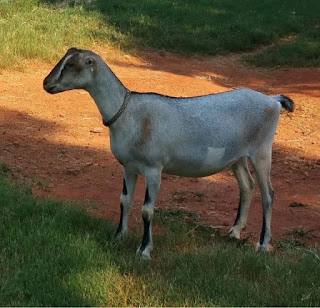Whether you just want milk for your family, or you plan to breed and sell goats, there is one, sometimes inconvenient, sometimes stinky thing you need, a buck. A dairy goat has to be bred and kid to give milk. To keep that milk flowing, she needs to kid every 1-2 years.
Bucks can be overwhelming to people just starting out. I didn't keep one the first year I had goats. After driving around taking goats on dates that first year, I decided pretty quickly that I needed a buck.
Pick a buck who will help to make your goats the best they can be, not one simply because he has the parts. Want more milk? Look at his dam and granddams' production. Need to improve certain conformational traits? Look for lines who are strong in that area. Remember, it doesn't cost all that much to have a buckling transported to you from anywhere in the country!
Your buck has one main job, to breed your does, but he will also alert you to when your does are in heat. His aroma, to put it nicely, will bring your does into heat sooner in the fall than if you do not have a buck on your property. Not only that, it is far easier to just throw an amorous pair in a stall together than to have to load him or her up for a date.
I am not in the business of leasing my bucks or studding them out for "driveway breedings". This is not because I am mean. I have spent hours researching each buck on our farm. They have been carefully selected to fill a need in our breeding program. We have spent thousands of dollars for them, their transportation here, and their feed and upkeep. We have spent thousands of dollars on their fencing and shelter. We spend hours mucking their stalls, trimming their hooves, bathing urine scalded legs, worming, vaccinating, clipping, feeding. We spend the fall tolerating the buck aroma wafting in our windows.
It is simply not worth the time or the risk to offer them for outside breeding.
I will occasionally let customers who buy does from me use my bucks the first fall. That allows them to get their feet wet into goats, discover what they should look for in a buck, and allow me to see some kids from that breeding, since I often have to sell goats I'd like to see kids from just to keep our numbers in line.
If you plan to keep goats, please keep a buck. One easy plan for new goat breeders is to keep a buckling. Most bucklings will ready to breed your does by 5-6 month old. They are small still, so they are easier to control and aren't as smelly. Buy a nice one, and you should have no trouble selling him when you're done with him. Or you could always eat him when he goes out of rut!
Anyway you slice it, bucks are a necessity. You may just end up liking the stinky boys.







